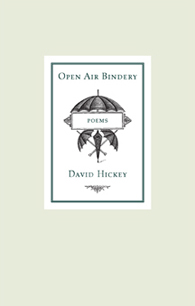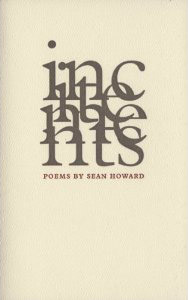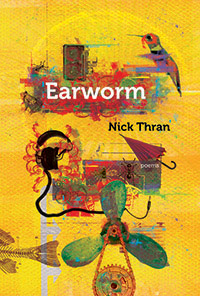Reviews
Poetry Reviews by Evan Jones
David Hickey, Open Air Bindery (Emeryville: Biblioasis, 2011). Paperbound, 72 pp., $18.95.
Sean Howard, Incitements (Kentville: Gaspereau, 2011). Paperbound, 96 pp., $19.95.
Nick Thran, Earworm (Gibsons: Nightwood, 2011). Paperbound, 72 pp., $18.95.
The common ground in these three slim sophomore collections by young men is well-trod at the moment: Stephen Burt identified it a couple of years back as “elliptical poetry”—and shortly afterward Tony Hoagland called it “the skittery poem of our moment.” Many of the poems in these collections are fragmented, associative, even, at times, anti-narrative, meeting the criteria set out by both Burt and Hoagland. Yet, while their forms and syntax may overlap, there’s no question these are books by individuals, and their themes and concerns couldn’t be more different.
David Hickey’s Open Air Bindery pairs disciplined studies like botany, astronomy,  and, curiously, bookbinding with a vague metaphysics. His “Hinterland Who’s Who” is a poem parody of the old CBC shorts, that runs the gamut and beyond of documentary voiceover techniques: “…the chimney swift is a small, sooty bird / that clings to the bricks of chimneys, / which is why // they call it the chimney / swift, not the telephone wire / warbler or the tall // tree startler….” The poem opens with a technical voice, moves on to sarcasm (“which is why / they call it the chimney / swift”), then subtly shifts to end in the out-there: “I’ll meet you there, / however it may / happen, someday on the soft side of masonry.” In this way, the faux documentarian’s metaphysics enter the poem—along with himself—right at the end, and it’s a trick Hickey makes much of throughout his poems. The move is subtle, smooth, and genuine, and it’s something Michael Ondaatje used to do a lot: here’s an object, here’s some description of it, and here’s why it’s important to me. What is unique in Hickey’s poems is the development from objective thing to metaphysical subjective. In this way, he mixes an imagistic “thing-ness” with a more postmodern personal. His subjects—his better subjects—are mostly solid things: a garden shed, marigolds, trees, drawings, paintings, harbours, and, again, books. However, with some of these subjects, and specifically books, the author wades into a sort of babbling-brook version of surrealism—but only up to his knees—the imagery and narrative of his poems becoming fantastic, but in a slight, minor way, as in “Footnote to the Book of Moonlight”: “…the book of moonlight never // did appear in paperback. / It was bound in an open air // bindery, just before / the collected sidewalk, just // after the selected raccoon.” Toying with the notion of what a book can hold—moonlight, sidewalk, raccoon—is all well and good, but the poem continues like this and a conclusion never really arrives. Perhaps because the poet enters only in a brief “if I remember correctly” way, the poem wanders and meanders without welcoming the reader into the water.
and, curiously, bookbinding with a vague metaphysics. His “Hinterland Who’s Who” is a poem parody of the old CBC shorts, that runs the gamut and beyond of documentary voiceover techniques: “…the chimney swift is a small, sooty bird / that clings to the bricks of chimneys, / which is why // they call it the chimney / swift, not the telephone wire / warbler or the tall // tree startler….” The poem opens with a technical voice, moves on to sarcasm (“which is why / they call it the chimney / swift”), then subtly shifts to end in the out-there: “I’ll meet you there, / however it may / happen, someday on the soft side of masonry.” In this way, the faux documentarian’s metaphysics enter the poem—along with himself—right at the end, and it’s a trick Hickey makes much of throughout his poems. The move is subtle, smooth, and genuine, and it’s something Michael Ondaatje used to do a lot: here’s an object, here’s some description of it, and here’s why it’s important to me. What is unique in Hickey’s poems is the development from objective thing to metaphysical subjective. In this way, he mixes an imagistic “thing-ness” with a more postmodern personal. His subjects—his better subjects—are mostly solid things: a garden shed, marigolds, trees, drawings, paintings, harbours, and, again, books. However, with some of these subjects, and specifically books, the author wades into a sort of babbling-brook version of surrealism—but only up to his knees—the imagery and narrative of his poems becoming fantastic, but in a slight, minor way, as in “Footnote to the Book of Moonlight”: “…the book of moonlight never // did appear in paperback. / It was bound in an open air // bindery, just before / the collected sidewalk, just // after the selected raccoon.” Toying with the notion of what a book can hold—moonlight, sidewalk, raccoon—is all well and good, but the poem continues like this and a conclusion never really arrives. Perhaps because the poet enters only in a brief “if I remember correctly” way, the poem wanders and meanders without welcoming the reader into the water.
Sean Howard’s Incitements is the most complex of these three books, and perhaps  the most literary, its three sections each relying on text from other sources as their foundation. The poems use a cut-up technique—a form of collage—usually derived from multiple sources, juxtaposing different sets of language, style, and subject matter to create something new. Think of early DJs, who would peel the labels from the records they were mixing to create beats and new sounds. In focussing on specific, identified texts, though, Howard’s book is cutup homage—like a popular artist sampling a well-known hit from the past, recreating even as it identifies, supplying new lyrics to an older melody. But Howard also sidesteps genre with his sampling. The book opens in Peter Sanger’s White Salt Mountain, and takes from it thirtyeight seven-line poems, which at their strongest are haiku-like fragments, fragile, imagistic, and loaded: “Hayfield: syntax’s / mizzle. Palm and // silence, Taoist / earrings in my // hand. Shelling / memory’s // camps” (“Sandpaper Postcards III”). The opening image, a hayfield as somehow equivalent or represented by the fine mist of syntax, works: a thing meeting an idea. The palm and the silence connect in the “Taoist earrings” in hand: a religion that calls for the simple and natural at its most basic level, and Poundian, too. Then, with sudden violence, the mood changes. The earrings are representative, symbolic (do they belong to the speaker? are they a gift for or from someone else?), yet the attack commences, linked to them, suggesting that whatever they represent is painful and in the past. This is interesting stuff but, unfortunately, not all the segments work this well. Some are cluttered, confusing, and lacking context, as in “XXXVIII”: “Thistle- / down silence, / Cordelia / breath- / ing.” Who is Cordelia? Is this a King Lear reference or can we connect the narrative of earlier pieces to her? Is she the “Grandmother” in part “XXX”? At times the mystery is laid on too thick. The second section does something similar to Merritt Gibson’s Summer Nature Notes (1982), extending the form of the first section, but maintaining the choppiness of syntax and imagery so there’s a feel of sameness to what’s happening. The third, the “Incitements” of the book’s title, taken from Michael Hofmann’s translation of Hans Fallada’s 1947 novel, Jeder stirbt für sich allein (published in the U.S. as Every Man Dies Alone), moves into a more interesting pattern from the first two sections: longer lines, more sentence-like constructions, and a real sense of context: “graffiti terrorists: not WORKing / WILL SET YOU FREE (guilty // of expression!) soldiers, ‘the hunch- / backs exterminated.’ love burning // in each cell.” Fallada’s novel is epic and engrossing—almost six-hundred pages in length—and it’s a book I happen to have read less than six months ago (I’ve read Sanger’s book, too), so can recognize much of the context. There isn’t room for me to retell the story of Otto and Anna Quangel and their friends and enemies in World War II-era Berlin, but it is a book less about the Quangels’ failure to incite the masses with their useless effort than the notion that any effort to resist oppression makes life more worth living than doing nothing. So, there’s a political message at work in “Incitements,” but whose is it? As someone who has read both texts, it’s difficult to say. Howard’s cut-ups draw out energies and sympathies from the original texts, but work best as homage, pointing readers to great elements in other books.
the most literary, its three sections each relying on text from other sources as their foundation. The poems use a cut-up technique—a form of collage—usually derived from multiple sources, juxtaposing different sets of language, style, and subject matter to create something new. Think of early DJs, who would peel the labels from the records they were mixing to create beats and new sounds. In focussing on specific, identified texts, though, Howard’s book is cutup homage—like a popular artist sampling a well-known hit from the past, recreating even as it identifies, supplying new lyrics to an older melody. But Howard also sidesteps genre with his sampling. The book opens in Peter Sanger’s White Salt Mountain, and takes from it thirtyeight seven-line poems, which at their strongest are haiku-like fragments, fragile, imagistic, and loaded: “Hayfield: syntax’s / mizzle. Palm and // silence, Taoist / earrings in my // hand. Shelling / memory’s // camps” (“Sandpaper Postcards III”). The opening image, a hayfield as somehow equivalent or represented by the fine mist of syntax, works: a thing meeting an idea. The palm and the silence connect in the “Taoist earrings” in hand: a religion that calls for the simple and natural at its most basic level, and Poundian, too. Then, with sudden violence, the mood changes. The earrings are representative, symbolic (do they belong to the speaker? are they a gift for or from someone else?), yet the attack commences, linked to them, suggesting that whatever they represent is painful and in the past. This is interesting stuff but, unfortunately, not all the segments work this well. Some are cluttered, confusing, and lacking context, as in “XXXVIII”: “Thistle- / down silence, / Cordelia / breath- / ing.” Who is Cordelia? Is this a King Lear reference or can we connect the narrative of earlier pieces to her? Is she the “Grandmother” in part “XXX”? At times the mystery is laid on too thick. The second section does something similar to Merritt Gibson’s Summer Nature Notes (1982), extending the form of the first section, but maintaining the choppiness of syntax and imagery so there’s a feel of sameness to what’s happening. The third, the “Incitements” of the book’s title, taken from Michael Hofmann’s translation of Hans Fallada’s 1947 novel, Jeder stirbt für sich allein (published in the U.S. as Every Man Dies Alone), moves into a more interesting pattern from the first two sections: longer lines, more sentence-like constructions, and a real sense of context: “graffiti terrorists: not WORKing / WILL SET YOU FREE (guilty // of expression!) soldiers, ‘the hunch- / backs exterminated.’ love burning // in each cell.” Fallada’s novel is epic and engrossing—almost six-hundred pages in length—and it’s a book I happen to have read less than six months ago (I’ve read Sanger’s book, too), so can recognize much of the context. There isn’t room for me to retell the story of Otto and Anna Quangel and their friends and enemies in World War II-era Berlin, but it is a book less about the Quangels’ failure to incite the masses with their useless effort than the notion that any effort to resist oppression makes life more worth living than doing nothing. So, there’s a political message at work in “Incitements,” but whose is it? As someone who has read both texts, it’s difficult to say. Howard’s cut-ups draw out energies and sympathies from the original texts, but work best as homage, pointing readers to great elements in other books.
The voice in Nick Thran’s Earworm is monotonous, but not one-note: it’s the  veering of the voice from dissociation to dissociation, from “trigger” to “trigger.” Often reliant on popular culture (“Glowed like a bouquet of E.T.’s / fingertips”), mixing the high and low as David McGimpsey does, Thran avoids punchlines and creates instead comic scenarios out of his juxtapositions. “Trigger”is a good example, and might even be an espousal of his poetics: ”His nickname then / was ‘the Animal,’ which signifies an excessive / wildness that is difficult for both the body // and time to sustain. ‘Gargamel’ / would have been much worse, // signifying an evil wizard on the Smurfs [sic] / who signifies, as well, a very real threat….” Key words “trigger” the turns in the poem—as in a psychological examination—moving, ducking, and dodging, and the only continuity is the lack thereof. Throughout the book, Thran writes one poem well: often in verse paragraphs of two lines. But it’s identifiable, pin-downable, when the poems are trying to be anything else. In varying this somewhat, towards the end of the collection, Thran includes a villanelle and a pantoum, but there the riff is taken from Mark Strand—whose Blizzard of One (1998) also included villanelles and pantoums and who is namechecked in Earworm. So, while the voice is solid, it sounds too familiar, too much the sum of influences and not enough its own.
veering of the voice from dissociation to dissociation, from “trigger” to “trigger.” Often reliant on popular culture (“Glowed like a bouquet of E.T.’s / fingertips”), mixing the high and low as David McGimpsey does, Thran avoids punchlines and creates instead comic scenarios out of his juxtapositions. “Trigger”is a good example, and might even be an espousal of his poetics: ”His nickname then / was ‘the Animal,’ which signifies an excessive / wildness that is difficult for both the body // and time to sustain. ‘Gargamel’ / would have been much worse, // signifying an evil wizard on the Smurfs [sic] / who signifies, as well, a very real threat….” Key words “trigger” the turns in the poem—as in a psychological examination—moving, ducking, and dodging, and the only continuity is the lack thereof. Throughout the book, Thran writes one poem well: often in verse paragraphs of two lines. But it’s identifiable, pin-downable, when the poems are trying to be anything else. In varying this somewhat, towards the end of the collection, Thran includes a villanelle and a pantoum, but there the riff is taken from Mark Strand—whose Blizzard of One (1998) also included villanelles and pantoums and who is namechecked in Earworm. So, while the voice is solid, it sounds too familiar, too much the sum of influences and not enough its own.
—Evan Jones









